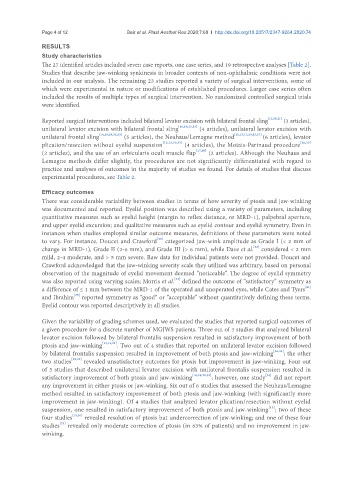Page 800 - Read Online
P. 800
Page 4 of 12 Bair et al. Plast Aesthet Res 2020;7:68 I http://dx.doi.org/10.20517/2347-9264.2020.74
RESULTS
Study characteristics
The 27 identified articles included seven case reports, one case series, and 19 retrospective analyses [Table 2].
Studies that describe jaw-winking synkinesis in broader contexts of non-ophthalmic conditions were not
included in our analysis. The remaining 23 studies reported a variety of surgical interventions, some of
which were experimental in nature or modifications of established procedures. Larger case series often
included the results of multiple types of surgical intervention. No randomized controlled surgical trials
were identified.
Reported surgical interventions included bilateral levator excision with bilateral frontal sling [13,19,21] (3 articles),
unilateral levator excision with bilateral frontal sling [16,19,23,33] (4 articles), unilateral levator excision with
unilateral frontal sling [16,28,29,32,33] (5 articles), the Neuhaus/Lemagne method [11,13,17,29,35,37] (6 articles), levator
plication/resection without eyelid suspension [13,15,30,33] (4 articles), the Motais-Parinaud procedure [26,33]
(2 articles), and the use of an orbicularis oculi muscle flap [27,30] (2 articles). Although the Neuhaus and
Lemagne methods differ slightly, the procedures are not significantly differentiated with regard to
practice and analyses of outcomes in the majority of studies we found. For details of studies that discuss
experimental procedures, see Table 2.
Efficacy outcomes
There was considerable variability between studies in terms of how severity of ptosis and jaw-winking
was documented and reported. Eyelid position was described using a variety of parameters, including
quantitative measures such as eyelid height (margin to reflex distance, or MRD-1), palpebral aperture,
and upper eyelid excursion; and qualitative measures such as eyelid contour and eyelid symmetry. Even in
instances when studies employed similar outcome measures, definitions of these parameters were noted
[35]
to vary. For instance, Doucet and Crawford categorized jaw-wink amplitude as Grade I (< 2 mm of
[22]
change in MRD-1), Grade II (2-6 mm), and Grade III (> 6 mm), while Dave et al. considered < 2 mm
mild, 2-4 moderate, and > 5 mm severe. Raw data for individual patients were not provided. Doucet and
Crawford acknowledged that the jaw-winking severity scale they utilized was arbitrary, based on personal
observation of the magnitude of eyelid movement deemed “noticeable”. The degree of eyelid symmetry
[34]
was also reported using varying scales; Morris et al. defined the outcome of “satisfactory” symmetry as
[21]
a difference of ≤ 1 mm between the MRD-1 of the operated and unoperated eyes, while Cates and Tyers
[35]
and Ibrahim reported symmetry as “good” or “acceptable” without quantitatively defining these terms.
Eyelid contour was reported descriptively in all studies.
Given the variability of grading schemes used, we evaluated the studies that reported surgical outcomes of
a given procedure for a discrete number of MGJWS patients. Three out of 3 studies that analyzed bilateral
levator excision followed by bilateral frontalis suspension resulted in satisfactory improvement of both
ptosis and jaw-winking [13,19,21] . Two out of 4 studies that reported on unilateral levator excision followed
by bilateral frontalis suspension resulted in improvement of both ptosis and jaw-winking [16,33] ; the other
two studies [19,23] revealed unsatisfactory outcomes for ptosis but improvement in jaw-winking. Four out
of 5 studies that described unilateral levator excision with unilateral frontalis suspension resulted in
[33]
satisfactory improvement of both ptosis and jaw-winking [16,28,29,32] ; however, one study did not report
any improvement in either ptosis or jaw-winking. Six out of 6 studies that assessed the Neuhaus/Lemagne
method resulted in satisfactory improvement of both ptosis and jaw-winking (with significantly more
improvement in jaw-winking). Of 4 studies that analyzed levator plication/resection without eyelid
[15]
suspension, one resulted in satisfactory improvement of both ptosis and jaw-winking ; two of these
four studies [13,30] revealed resolution of ptosis but undercorrection of jaw-winking; and one of these four
[33]
studies revealed only moderate correction of ptosis (in 63% of patients) and no improvement in jaw-
winking.

